 Previous Article
Previous Article
Decking Ideas For Your Garden
All decking needs maintenance. Mother Nature’s elements, including the sun, are powerful enough to break atoms apart. The biggest question is how much maintenance is needed when comparing wood and composite decking.
Wood requires a lot of maintenance and specialist chemical treatment to stop it from warping, cracking, splintering and rotting. The build-up of mould, moss, algae and UV fading also needs to be considered. A high degree of labour and time is required to maintain your wood decking every season during its short service life.
Composite decking is not maintenance-free; it’s low maintenance. It absorbs minimal moisture and doesn’t require refinishing, sealants, or staining. However, it does need to be cleaned once a month using soapy water and a low-power washer or soft-bristle brush.



Installing a new composite deck is a big investment. Performing due diligence will help you get it right the first time. Your deck will be a space for socializing and relaxing year-round, so it’s wise to invest in high-quality composite decking. Ensure experienced installers fit your deck correctly. This guarantees long-term durability and adds value to your property.
Wood may start strong, but if not maintained, it suffers from pest infestations, mould, splitting and weakening over time. Composite decking maintains its strength more consistently over the years, especially solid boards, which tend to be stronger than hollow ones.

|
Strength (1 year) | Strength (10 years) | Cost (10 years) |
|---|---|---|---|
| Wood | Good (34–45 MPa) | Poor (Weakens over time) | £££ |
| Hardwood | Best (51+ MPa) | Good (Loses some strength) | ££ |
| Composite | Good (34–46 MPa) | Excellent (Consistent) | £ |
Both composite and timber are good environmental choices if sourced responsibly. However, what happens post-installation is equally important.
Softwoods can leach chemicals into soil and are difficult to recycle. Composite decking, made from recycled plastic and wood, reduces landfill waste and doesn’t require toxic treatments.
The authentic natural wood look is extremely important to a lot of customers. Composite have been know over the years for an synthetic appearance, in which can turn some customers away, pressure treated woods can also look unnatural in some customers personal views, but recent changes in production are enhancing composites natural appearance and even capturing hardwood turn beauty.
Nothing beats the real version and for us no wood and design equals hardwood decking for an authentic wood look, its simply the real deal as you say. Our Composite on other hand are extremely close, the recent changes in production for are able to successful captures the mix and flow of colours that your see in exotic wood, you only need to review our exclusive collection to see this.
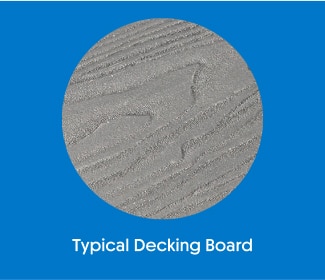
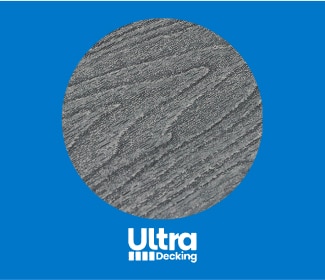
This is another important feature. Customers are often concerned about slippery boards, especially if they have children or pets. Wood is known for being slippery more so in wet condition and after a number of years of use. Composite decking dos have improved slip resistance with an excellent resistance to slip in dry and good resistance to slip in very wet condition, but like and material you can still slip
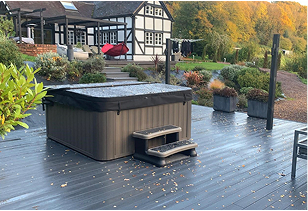
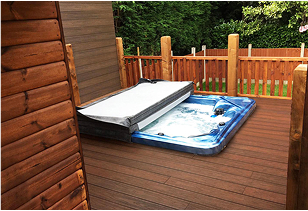
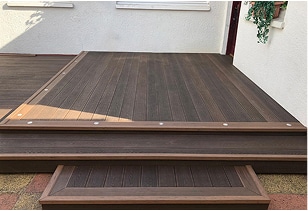
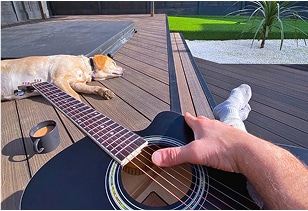
Wood decking is extremely slippery and hazardous. This is mainly due to the growth of algae and moss, which needs to be regularly treated to stay under control. These treatments can cost time and money. As wood ages and if the incorrect maintained and care isn’t complete with hardwood and softwood then they can become very slippery
Composite decking is highly slip-resistant. Even when the boards are wet, Composite decking does not have the annoying defect of being slippery, mainly due to the high grade and quality of the raw materials used.
Please note: Although we describe our composite decking boards as “slip-resistant,” it goes without saying that with any decking solution if the surface has oil, slippery products, and excessive water or ice on the decking boards, they will still become slippery.
Colour fading is another important feature usually researched and commonly asked about. Have you ever noticed that your decking is not as vibrant as it used to be? Or perhaps you noticed that some parts of the deck are different from the others. It is because of the colour fading, which can be caused by various reasons.
Wooden decking can fade aggressively its colour consistency is poor and requires consist maintenance to retain and maintain its colour. Even though some woods hold they colour for longer the result in time in most cases is the same turning to a dull grey.
If you replace your wooden decking with composites, you will see that the colour consistency is much better. The colour with composite still does fade, uncapped boards see the most and capped boards see extremely minimal colour change, even after several years. Uncapped boards as mentioned are the worse for colour change with composites, but even then they lighten around 30% but still maintain there original colour base being a grey or brown after several years. So even when comparing uncapped boards with wood the colour consistency is much better.

When choosing your new decking area, one of the biggest factors to consider is cost. While wood is generally cheaper than composite decking at the time of initial installation, composite decking becomes more cost-effective over time—especially if you’re planning to stay in your home for more than two years.
In this article, we’ve compared wood, hardwood, and composite decking. From a cost perspective, we’ve analyzed the full range of composite decking options and provided a detailed price comparison with wood.
To break it down further, we’ve taken an average decking area of 15 square meters and compared the total cost with wood decking. For this comparison, we’ve included the cost of regular cleaning once a month for one year valued at £13.50 per hour for your time.

|
Softwood | Hardwood | Uncapped Composite | Mixed Colour Composite | Capped Composite |
|---|---|---|---|---|---|
| Initial Cost | £1,000 | £2,500 | £1,500 | £1,600 | £1,700 |
| 5 Year Cost | £3,000 | £5,000 | £2,000 | £2,000 | £1,800 |
| 10 Year Cost | £6,000 | £10,000 | £4,000 | £3,000 | £2,800 |
| 5-Year Winner | Cheaper than Softwood after 5 Years | Cheaper than Softwood after 10 Years |
 |
||
| 10-Year Winner |
 |
One aspect is to compare wood and composite over time is maintenance, another in which is worth looking into is replacement. After 5 years some softwoods will need replacing, so lets go a little deeper and have a look at replacement costs over 5 to 15 years when comparing wood and composites together.
In relation to replacement and longevity over a period of 15 years wood unmaintained will of been replaced a total of 2/3 times times and minimum in our view of twice costing anywhere from £2700 to £4050 for replacement materials and labour.
Hardwood will still be going, however there is a high chance rotting and decay would be showing or even causing it to be replaced. Hardwood compared to uncapped boards in relation to longevity and life span is equal, the only difference in our view is the colour consistency.
Uncapped boards will provide a better consistency of colour compared to hardwood and is less maintenance is involved, as you seen above, so we would recommend uncapped boards over wood and even hardwood.
Capped boards on the other hand will of retained its colour, still be holding its structural integrity and going for another decade. If longevity beyond 10 years is key and you will of course benefit from capped decking and this would be our recommend decking solution.
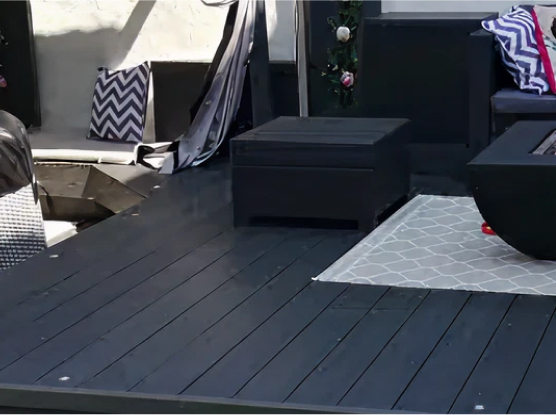

|
Wood | Hardwood | Capped Composite | Uncapped Composite | Mixed Colour Composite |
|---|---|---|---|---|---|
| After 5 Years |
Rotten & Unsafe Needs Replacement ££££ |
Structurally Sound No Replacement Needed |
Structurally Perfect No Replacement Needed |
Structurally Sound No Replacement Needed |
Structurally Sound No Replacement Needed |
| After 10 Years |
Rotten & Unsafe Needs Replacement ££££ |
Early Rot Needs Replacement ££££ |
Minimal Wear No Replacement Needed |
Faded No Replacement Needed |
Slight Wear No Replacement Needed |
| After 15 Years |
Rotten & Unsafe Needs Replacement ££££ |
Rotten & Unsafe Needs Replacement ££££ |
Slight Wear No Replacement Needed |
Worn Needs Replacement ££££ |
Worn Needs Replacement ££££ |
We have explored all points when comparing wood and composite boards, wood may be cheaper on initial price and this is great for a short term solution, so if your staying in property for lower than 5 years then wood or softwood will be perfect.
If you looking for a solution to last beyond 5 years then hardwood and composite boards are the recommend decking solution.
If longevity, colour consistency and low maintenance is key for you then composite boards are most defiantly the recommend chose, even though hardwood can last as long as most composite boards, its consistent maintenance and low colour consistency when compared to composite material would take hardwood of the list of recommendation.
If you looking for a long lasting solution lasting beyond 5-10 years, with minimal colour change and strong long term structural integrity then capped boards.
While hardwood offers unbeatable authenticity, modern composite decking is incredibly close and far more consistent over time.
 Previous Article
Previous Article
Decking Ideas For Your Garden

Cheap decking ideas